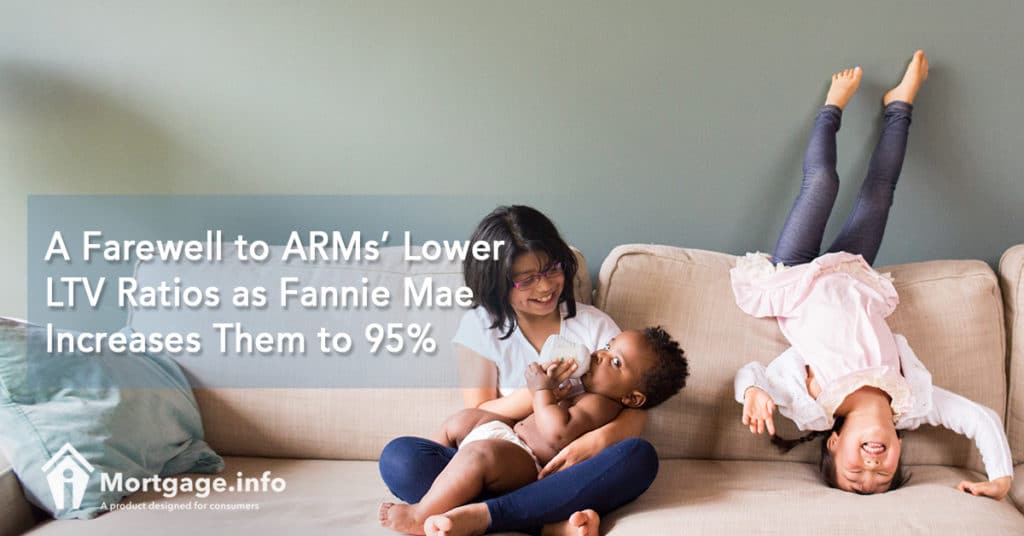Prior to the July 29 Fannie Mae changes, adjustable-rate mortgages required lower loan-to-value, combined loan-to-value, and high combined loan-to-value than fixed-rate mortgages. These low LTV ratios make applying for ARMs less attractive and more difficult for Americans looking to borrow more or afford a larger home, perhaps.
Blame it on their unsavory past during the housing crash, but the term adjustable-rate mortgages alone can sometimes instill fear in the minds of potential borrowers as they consider their mortgage options. This stigma is not the primary reason why ARMs dropped from nearly 35% of all mortgages in 2006 to around 6% currently. It’s the tougher qualifying terms that up to now kept borrowers from really considering this option.
Ironically, most people with an ARM the past decade have been very happy watching their rates adjust downward and have had little reason to leave those loans.
With the release of Fannie Mae’s Desktop Underwriter® Version 10.1, homeowners seeking ARMs can qualify for higher LTV ratios up to 95%. This enhancement is not exclusive to DU® loans as manually underwritten loans can benefit as well.
The increased ARM LTV ratios are in line with Fannie Mae’s goal to support access to credit and simplify its guidelines. That being said, more homeowners will be added to ARMs’ usual pool of borrowers, those who are on the move and those looking to take advantage of low starter rates.
This upgrade in ARM LTV ratios also translates to a higher purchasing power, requiring less down payment on a purchase or less equity to do a refinance.
[sc_content_link label=”Find out how can now access conventional financing easier here.”]
Fannie Mae Raises ARM LTV Ratios to 95%
Fannie Mae has increased the maximum allowable LTV, CLTV and HCLTV (collectively referred to as LTV ratios) for adjustable-rate mortgages across all transaction, occupancy and property types, up to 95%.
Loan to value ratio is your loan amount divided by the appraised value of your property. Previously, LTV ratios for ARM products were lower by 10% from those of fixed-rate mortgages.
Effective July 29, the maximum allowed LTV ratios for all ARMs will have increased to align with FRM LTV ratios.
An updated matrix of LTV ratios for conventional ARMs and FRMs eligible for delivery to Fannie Mae is accessible here.
Will Prices of ARMs Go Up?
ARMs have been known to be priced lower than FRMs. This is evident in rates surveyed by Freddie Mac’s Primary Mortgage Market Survey (PMMS). For example, the 5-year hybrid ARM rate is always lower compared with the 15-year and 30-year FRM average rates.
With the increase of ARM LTV ratios, Fannie Mae has updated its loan-level price adjustment (LLPA) schedule, which is a standard risk-based pricing among all conventional loans.
The LLPAs are based on the eligibility requirements and features of the loan such as product type, purpose, occupancy, and credit score.
As to ARMs, the LLPA for a variable loan with a 95% LTV ratio is 0.250%. This LLPA will be reflected in your mortgage rate.
[sc_content_link label=”Let us help you find a lender.”]
When an ARM Is Acceptable to Fannie Mae
Fannie Mae lays down a number of attributes for variable-rate loans to be eligible for its purchase.
For one, Fannie does not have a minimum remaining term requirement but it does require an ARM to have a (i) lifetime cap and (ii) a per-adjustment cap.
However low its rate floor cap can go; the variable rate must not go lower than its margin.
Fannie Unveils 5/5 ARM Plan
Based on the standards above, Fannie Mae has recently unveiled a five-year ARM plan to join its array of standard ARM products. The 5/5 ARM plan has the following characteristics:
- An initial fixed rate period of 5 years
- Subsequent adjustments of every 5 years
- An index tied to 5-year Weekly CMT
- Rate caps of 2% for initial adjustment and 2% for subsequent adjustments
- A lifetime interest rate cap of 6%
- A lifetime interest rate floor
Fannie Mae’s higher ARM LTV ratios opens the conventional credit box for consumers with down payments not higher than 5% or have little equity built in their homes to refinance.
[sc_content_link]

